Nasdaq OMX, at a time of intense suspicion surrounding high-frequency trading practices, has consented to allow the Securities and Exchange Commission to regulate its co-location services.

"We have been asked by the SEC and consented to–indeed embraced–their regulation of our co-location business," Eric Noll, a Nasdaq executive vice president in charge of transaction services, told Traders Magazine. "Their goal is to make sure that access to our marketplace is fair. That is also our goal."
As part of the new regulation process, Nasdaq will submit any pricing changes to the SEC for approval, Noll said. The move comes at a time of increased fear and scrutiny of high-frequency traders, the group most closely associated with the placement of trading servers in close proximity to exchanges’ matching engines.
Many believe the marketplace is developing into a two-tiered environment with fast-on-the-draw high-frequency traders having the upper hand. They believe that co-location confers unfair advantages upon high-frequency trading firms.
Co-location is a service offered by market centers and third parties, such as Equinix, that involves making rack space available to firms for their trading servers in facilities near market centers’ matching engines.
Nasdaq works in partnership with Verizon, but largely controls the marketing and management of its co-location efforts. NYSE Euronext does everything on its own. (The exchange operator would not comment on whether or not the SEC intends to oversee its services.)
The other two major market operators–BATS Exchange and Direct Edge, an ECN–have chosen not to get into the business of selling rack space. They have entered into agreements with Savvis, BT Radianz and Equinix to market and manage their co-location efforts. Placing one’s trading server nearer to an exchange matching engine reduces communication times, increasing the chances of beating competitors to profitable trading opportunities.
Many of these data centers are in New Jersey where NYSE Euronext is building a 400,000-square-foot facility for co-location purposes.
Because of the perception of unfairness, some in the industry have argued more transparency into the allocation practices of exchanges’s co-location business is warranted.
"Let’s get it out in the open," Bryan Harkins, an executive with Direct Edge, said at this year’s Traders Magazine conference. "What does it cost to get a rack? How do I get a rack? Make it transparent. List fee schedules and membership costs."
A spokesperson for Direct Edge says the firm sees no problem with other marketplaces getting into the business, but believes it should be regulated.
At least one high-frequency trader shares that view. "Exchanges are very fair in how they allocate space," Richard Gorelick of RGM Advisors said at the same conference. "A regulatory structure around that would be helpful to make it clear that nobody is getting an unfair advantage."
Chris Isaacson, BATS’s chief operating officer also believes managers of co-location space operate fairly, but that the business should be left to third parties such as Equinix. The exchanges that do engage in selling rack space are in a "conflicted position" by running a market center and taking on the job of divvying up co-location space, he said.
Noll contends a regulated co-location business is better than no co-location business. If the SEC decided to ban exchange operation of co-location facilities, then unregulated "wildcat operators" would step in to offer it. "They would be unregulated and would not ensure fair access," he said.
"Co-location is not going away," Noll added. "But the way the market is evolving is positive. Exchanges are providing it and it’s regulated and access is fair."
(c) 2009 Traders Magazine and SourceMedia, Inc. All Rights Reserved.
http://www.tradersmagazine.com http://www.sourcemedia.com/






